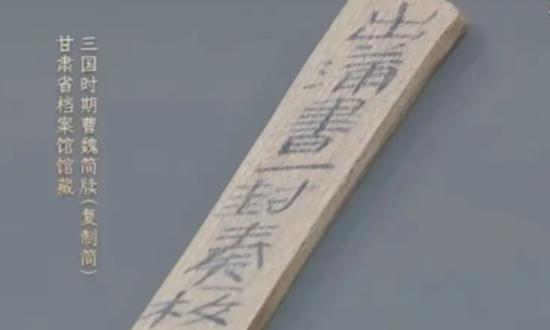China's oldest known bamboo slip from the Cao Wei state found in Gansu

The oldest known bamboo slip dated from the Cao Wei state of the Three Kingdoms period (220-280) has been discovered during a study of 216 -previously unreleased slips collected by the Gansu Provincial Archives and Gansu Jiandu Museum, offering rare insights into the administrative and military life along the ancient Silk Road more than 1,700 years ago, CCTV News reported on Monday.
According to CCTV News, the finding emerged from a joint research project that examined 216 previously unreleased bamboo and wooden slips held in the archives' collection.
"We're currently studying and interpreting this batch of 216 slips that have never been made public before," said Sun Xiaoyun, director of the development and utilization division at the Gansu Provincial Archives.
"Among them, we made a particularly significant discovery: the oldest slip dated from the Cao Wei state of the Three Kingdoms."
Jiandu are the bamboo and wooden slips on which ancient Chinese people wrote using ink and brushes before the invention of paper. To date, the vast majority of known and studied slips were from the Qin Dynasty (221BC-206BC) and Western Jin Dynasty (265-316). Discoveries from the Cao Wei state of the Three Kingdoms have been exceedingly rare, with only a few dozen slips found prior to this new find.
Xiao Congli, head of the sorting and research department at the Gansu Jiandu -Museum, told the Global Times that this particular slip records the delivery of official documents between a courier and a postal officer and is dated explicitly to a day in June in the second year of Jingchu, or the year 238.
This seemingly ordinary mail delivery record offers a valuable time marker.
The Jingchu era refers to the reign of Cao Rui, also known as Emperor Ming of Wei, who was the son of Cao Pi and grandson of the warlord Cao Cao - key figures in the tumultuous Three Kingdoms era.
The year 238, when this slip was written, was a time of intense military activity. Historical accounts suggest that this was when Jiang Wei, a famed general of the Shu state, launched his first northern campaign against Wei forces. Some believe he was stationed in Hanzhong alongside commander Jiang Wan before leading a detachment westward into Longyou, an area now part of modern-day Gansu Province.
While scholars cannot yet confirm whether the slip is directly connected to these military events, its timing and geographic origin evoke the wartime backdrop of more than 1,700 years ago.
Besides this slip, other slips among this batch also provide further insight into the military and administrative structures on China's northwestern -frontier during the Han -Dynasty (206BC-AD220).
"We found out that the content of many of the 216 slips is unprecedented, including rare references to frontier military outposts, -fengshui-related practices, thus enriching understanding of the defensive infrastructure along the Great Wall and the social systems of the Hexi Corridor. Their diverse formats and long chronological span also provide valuable insight into governance, communication, transportation, and social life along the Silk Road," Xiao added.
Xiao further noted that some records confirm that Xuanquanzhi, a postal relay station established during the Han Dynasty near Dunhuang and the only fully excavated Silk Road courier site in China, remained in operation into the Three Kingdoms, demonstrating its enduring role in regional logistics.
